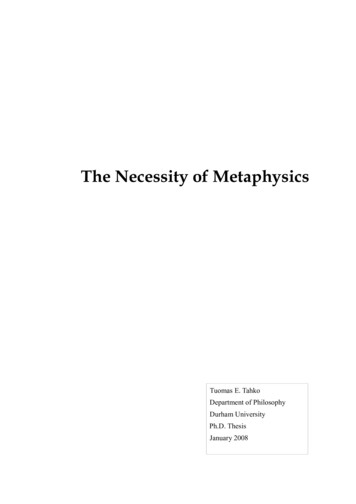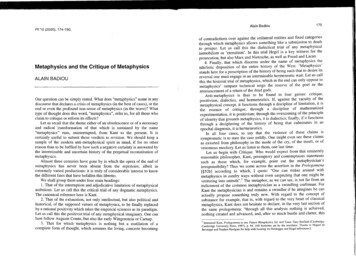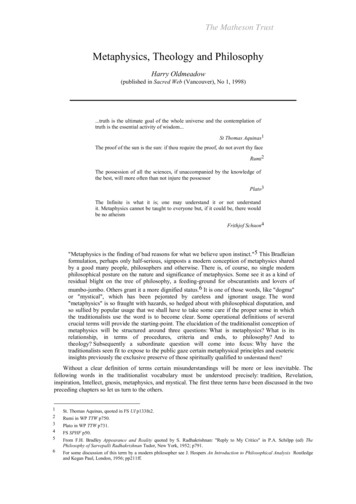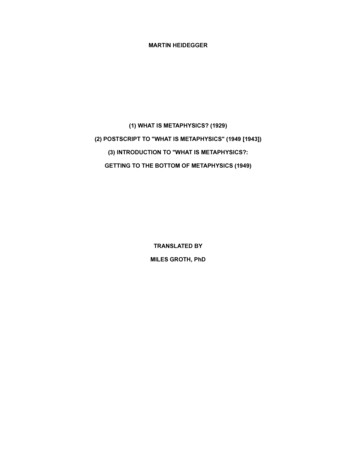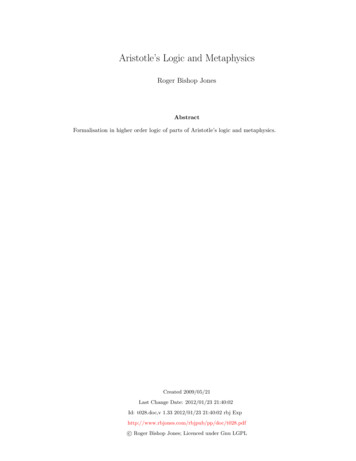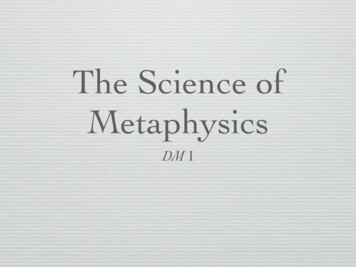
Transcription
The Science ofMetaphysicsDM I
Two Easy Thoughts Metaphysics studies being, in an unrestricted way: So, Metaphysics studies ens, altogether,understood either as: Ens comprising all beings, including per se, peraccidens, and entia rationis. Or, if the last is a bridge too far, then comprisingall real beings, whether per se or per accidens.
The First Opinion The first opinion, then, is that being, taken in themost abstract way, insofar as it embraces under itselfnot only all real beings, both per se and per accidens,but even beings of reason, is the appropriate objectof this science. (DM I 1.2) Prima igitur sententia est ens abstractissime sumptum,quatenus sub se complectitur non solum universa entiarealia, tam per se quam per accidens, sed etiam rationisentia, esse obiectum adaequatum huius scientiae.
Three Kinds of Beings (Kind of. . .) Some simple first approximations: A via negativa: x is an ens per se df (i) x exists formally and not merely objectively; (ii) and x does not exist ‘inanother’ (in alio) x is an ens per accidens df (i) x exists formally and not merely objectively; (ii) and x does exist ‘inanother’ (in alio)Not terribly helpful . . .Better: x is an ens per se df (i) x exists formally and not merely objectively; (ii) necessarily, an account(ratio) of x makes reference to x’s being φ, where φ is a substance sortal; and (iii) there is no ψ,where ψ is not a substance sortal, such that an account of x necessarily makes reference to ψ. x is an ens per accidens df (i) x exists formally and not merely objectively; (ii) necessarily, anaccount (ratio) of x makes reference to ψ, where ψ is not a substance sortal, and (iii) andnecessarily , an account of being-ψ makes reference to being φ, where φ is a substance sortal.
Some Terminology φ is a sortal iff (i) φ is a predicate; (ii) φ provides so-called counting criteria for a class Consequently, typically, but not always, the notion of a sortal is wed to the notion of acount noun. Count allow us to answer ‘How many?’; mass nouns require us to ask ‘How much?’ ‘A sortal universal supplies a principle for distinguishing and counting individualparticulars which it collects.’ —Strawson (1959)φ is a substance sortal iff (i) φ is a sortal; and (ii) φ specifies the essence of its bearer; or (ii) φprovides grounds for determining existence and persistence conditions for things fallingunder it. N.b. To some ears ‘substance sortal’ sounds pleonastic. So Wiggins: ‘By an ultimatesortal I mean a sortal which either itself restricts no other sortal or else has a sense whichboth yields necessary and sufficient conditions of persistence for the kind it defines and issuch that this sense can be clearly fixed and fully explained without reference to anyother sortal which restricts it.’ (1967: 32)
Three Kinds of Beings (Kind of. . .) x is an ens rationis df x has ‘being only objectively in the intellect’ or equivalently, ‘that which is thought by reason as being, even though it has no entity initself.’ (DM LIV 1.6) An ens rationis ‘does not have in itself any other real or positive being besides being anobject of intellect.’ (DM LIV 1.6) Such a being is in reason ‘objectively and does not have another more noble or morereal way of being’ (DM LIV 1.6) Aliquid vero interdum obiicitur seu consideratur a ratione, quod non habet in se aliud reale ac positivum essepraeterquam obiici intellectui seu rationi de illo cogitanti, et hoc propriissime vocatur ens rationis, quia estaliquo modo in ratione, scilicet, obiective, et non habet alium nobiliorem aut magis realem essendi modum, undepossit ens appellari. Et ideo recte definiri solet ens rationis esse illud, quod habet esse obiective tantum inintellectu, seu esse id, quod a ratione cogitatur ut ens, cum tamen in se entitatem non habeat. (DM LIV 1.6) A simple first approximation: x exists objectively df x’s existence constitutively depends upon x’sbeing cognized by an intellect.
So, A First Easy Thought So, Metaphysics studies ens, altogether,understood either as comprising all beings,including beings per se, per accidens, and entiarationis.
Absolute Generality This opinion is urged, first, because being, so taken, can be the appropriateobject of some science; therefore, most especially the object of this science,which is the most abstract of all the sciences. The premiss is evident, bothbecause being is presented to the intellect in that whole breadth, and cantherefore also be the object of a single science, for it is a single ratio; and alsobecause, just as the intellect understands all those things, so does this sciencetreat of all those things, namely, beings of reason and real beings, both per seand per accidens; therefore, if for that reason they are contained under theobject of the intellect, for a similar reason they should be contained under theappropriate object of this science; therefore, being, insofar as it is the objectof this science, should be taken under that abstraction and breadth accordingto which it directly comprehends all these things; and in the same way shouldone take the common attributes that are dealt with by this science, such asare unity, multitude, truth, and the like. (DM 1 1.2)
One Approach1. Entia per se, per accidens, and rationis exhaust all the entia there are.2. If the entia exhausting all the entia there are share a common ratio(scil. existing), then since this is the most abstract ratio of all, they willprove the (only) appropriate objects of the most abstract science.3. Metaphysics is the most abstract science.4. Hence, entia per se, per accidens, and rationis are the (only) appropriateobjects of metaphysics. Further, it will fall to this science to consider them as beings,together with the common attributes with which metaphysics dealssuch as unity, multitude, truth, and so forth.
No Good No entia per accidens: Since, then, this being per accidens is not one thing, but an aggregation ofmany, it cannot have a proper definition, nor can the real passions that aredemonstrated to belong to it; and therefore it does not fall under a science. But if such a being were considered insofar as it is in some way one, andits unity in some way real, in that case such a being would not beconsidered insofar as it is altogether per accidens, but insofar as it is insome way comprehended under the scope of being per se, although perhapsin that scope it holds some imperfect rank; for there are various modes ofbeing per se and per accidens, as we shall make clear in its proper place,while treating of unity. It is for this reason that I said that the discussionconcerns being per accidens as such; for a being per accidens, as such, is not abeing, but beings. . . (DM I 1.5)
Still No Good Suppose we think of them as unified by the intellect, so that they are oneand not many: If, however, that unity does not exist in reality, but only inapprehension or conception, such a being, as such, will not truly becalled real: whence the same argument will apply to it as applies toother beings of reason. But these are excluded from the directconsideration of this science by the same Aristotle, Metaph. VI,near the end, as all interpreters have noted in [their commentarieson] the same place. And the reason is that such beings are not trulybeings, but rather beings in name only, nor do they agree with realbeings in the same concept of being, but only through a kind ofimperfect analogy of proportionality, as we shall see below.
What is this talk of analogy? ‘. . . there are two ways in which something common can be divided into those that areunder it, just as there are two ways in which something is common. For there is the divisionof something univocal into its species by differentiae in terms of which the nature of the genusis equally participated in the species, for example as animal is divided into man and horse,and the like. Another division is that of something common by analogy, which is predicatedin one of the divisions according to a complete account (ratio) and in the other imperfectlyand in a certain way, as for example being is divided into substance and accident, and intobeing in actuality and being in potentiality: and this sort of division is as it were midwaybetween equivocity and univocity.’ ‘ est duplex modus dividendi commune in ea quae sub ipso sunt, sicut est duplex communitatis modus.Est enim quaedam divisio univoci in species per differentias quibus aequaliter natura generis in speciebusparticipatur, sicut animal dividitur in hominem et equum, et hujusmodi; alia vero divisio est ejus quod estcommune per analogiam, quod quidem secundum perfectam rationem praedicatur de uno dividentium, etde altero imperfecte et secundum quid, sicut ens dividitur in substantiam et accidens, et in ens actu et inens potentia: et haec divisio est quasi media inter aequivocum et univocum.’ Cajetanus, In SecundumSententiarum 42.1.3
Thinking Thomistically Univocity a and b are univocally φ iff: (i) a is φ; (ii) b is φ; and (iii) the accounts of φ-ness in 'a is φ' and'b is φ' are the same. These accounts must be bon-disjunctive: Water df (i) H2O; or (ii) x, y, and z; or (iii) . . . Real, rather than nominal:So, e.g.: Water is the clear, potable liquid of which lakes and rivers are composed andwhich falls as rain and issues from springs.Equivocity a and b are equivocally φ iff: (i) a is φ; (ii) b is φ; and (iii) the accounts of φ-ness in 'a is φ'and 'b is φ' have nothing in common and do not overlap in any way.
Two Flavours of Thomistic Analogy a and b are analogically φ iff: (i) a is φ; (ii) b is φ; (iii) a and b are nonmetaphorically φ; and (iv) a and b are neither univocally nor equivocally φ. Source Dependent Analogy (SDA) a and b are analogically φ in a source dependent way iff: (i) a is φ;(ii) b is φ; and (iii) there is some c such that the accounts of φ-ness in 'a isφ' and 'b is φ' necessarily make reference to the account of φ-ness in 'c is φ'in an asymmetrical way.Ordered Analogy (OA) a and b are analogically φ in an ordered way iff: (i) a is φ; (ii) b is φ;and (iii) the account of φ in 'b is φ' necessarily makes reference to the accountof φ in 'a is φ' in an asymmetrical way.
An Orthogonal (?) Distinctionwithin the Works of Suárez a and b are proportionally analogically φ iff: (i) a and b are analogically φ; (ii) there issome R such that Rac and some d such that Rbd; (iii) a and c and b and d are in differentdomains. As a first pass, this seems an extrinsic matter. It also seems to threaten second-order univocity. So, e.g., ‘is a source’ (principium) said of a spring and the first number in a seriesa and b are attributively analogically φ iff: (i) a and b are analogically φ; (ii) a and b areeither meet either (SDA) or (OA) At first pass, this seems an intrinsic matter. So, e.g., ‘is healthy’ said of Duns Scotus and his cheeks; or ‘is intelligent’ said ofProfessor Cross and God
So, analogy? So, we are looking not for sameness of accounts ( univocity), and notfor asymmetric dependence of accounts ( source-dependenthomonymy), and not for complete difference of accounts ( homonymy by chance), but rather: a four-term relation of the following form: a:b::c:d So, e.g.: sight : body : : reason : soul spine : fish : : bone : (land) animal (APo. 97b-98a)
Analogy Explicated in the Topics (108a) Likeness should be studied, first, in the case of things belonging todifferent genera; the formulae being A: B : : C: D as knowledge stands to the object of knowledge, so is sensationrelated to the object of sensation,and 'as A is in B, so is C in D' as sight is in the eye, so is reason in the soul, and as is a calm in the sea, so is windlessness in the air.
Two types? Hesse reads two distinct types of analogy into these remarks: (i) ‘When there are properties in common between parts of themembers of different species, for example spine and bone share an"osseous nature’ (ii) ‘When there is similarity in the relation of the parts to the wholein each species, for example cup is the symbol of Dionysus asshield is of Ares, and, more typically, hand and claw, scale andfeather, wings and fins, and so on, have similar structural positionsor functions in relation to their respective organisms.’ (1965, 330)
Trivialization Analogy in any sense other than mathematicalproportionality ‘is merely the fact that some relationshave more than one example.’ —Robinson (1952,466) So, ‘A : B :: C : D’ simply asserts the existence of arelation R such that aRb and cRd. If this trivialization holds, then so too does the claimthat univocity re-enters in second-order way.
Back to those Beings So, back to entia per accidens and entia rationis: If, however, that unity does not exist in reality, but only inapprehension or conception, such a being, as such, will not truly becalled real: whence the same argument will apply to it as applies toother beings of reason. But these are excluded from the directconsideration of this science by the same Aristotle, Metaph. VI, near theend, as all interpreters have noted in [their commentaries on] the sameplace. And the reason is that such beings are not truly beings, butrather beings in name only [or, are not true beings, but merely bear thename alone; quia talia neque vere sunt entia sed fere nomine tantum], nor dothey agree with real beings in the same concept of being, but onlythrough a kind of imperfect analogy of proportionality, as we shall seebelow.
The Appropriate Object It must be said, therefore, that being insofar as it isreal being is the appropriate object of this science.(DM I 1.26) Dicendum est ergo ens in quantum ens reale esse obiectumadaequatum huius scientiae.
Why? And this claim is proved on the basis of what has been said thus far againstthe other opinions. For it has been shown that the appropriate object of thisscience should include God and the other immaterial substances, but notonly these. Likewise, that it ought to include not only substances, but alsoreal accidents, though not beings of reason or beings that are altogether peraccidens; but there can be no object of this sort other than being as such;therefore, that is the appropriate object. (DM I 1.26) Probataque est haec assertio ex dictis hactenus contra reliquas sententias. Ostensumest enim obiectum adaequatum huius scientiae debere comprehendere Deum et aliassubstantias immateriales, non tamen solas illas. Item debere comprehendere nontantum substantias, sed etiam accidentia realia, non tamen entia rationis et omninoper accidens; sed huiusmodi obiectum nullum aliud esse potest praeter ens ut sic; ergoillud est obiectum adaequatum.
But, wait. . . But, in order to further clarify this claim, an objection thatimmediately presents itself must be addressed, for, in order to establishsome object of a science, it is necessary that it have properties whichcan be demonstrated of it, and also principles and causes throughwhich they can be demonstrated; but being insofar as it is beingcannot have such properties, principles, and causes; therefore. . . (DMI 1, 27) Sed, ut haec assertio amplius declaretur, occurrendum est obiectioni quae statimsese offert, nam ad constituendum aliquod obiectum scientiae,necesse est uthabeat proprietates quae de illo demonstrari possint et principia ac causas perquas possint demonstrari; sed ens, in quantum ens, non potest habere huiusmodiproprietates, principia et causas; ergo . . .
The Conception of Science Assumed Broadly conceived, scientia is an organized and articulated body of knowledge So, this extends to any such body, in any area, provided that it meets three criteria: Any given scientia must deal with a single domain, unified by a shared essence Any given scientia must put on display the priority relations between essences and otherfeatures of entities in the domain Any given scientia must proceed via demonstrations, that is, deductions, or logically validsyllogisms that: the premises are necessary; the premises are better known than their conclusions; and the premises are universal in scope (APo 71b16-25, 77b5-73a6; Met. 981a5-30,1006a6-18, 1039b27-1040a7)
Possible for ens in so far as it is real ens?1. Necessarily, if there is a science of being in so far as itis being, then: (i) there are properties attaining to beingjust in so far as it is being; and (ii) there are principlesand causes from which these properties can be derived.2. Being just in so far as it is being lacks such propertiesand principles.3. Hence, there is no science of being just in so far as it isbeing.
Why (2)? And the minor is clear with respect to its first part, since beinginsofar as it is being, abstracted in this way, is included per seand essentially in every being and in every mode or property ofany given being; therefore, it cannot have a property that is inthis way appropriate and proper, since a subject cannot be ofthe essence of its property. (DM I 1, 27) Minor autem quoad priorem partem patet, quia ens in quantum ens itaabstractum includitur per se et essentialiter in omni ente et in omnimodo vel proprietate cuiuslibet entis; ergo non potest habere proprietatemita adaequatam et propriam, quia subiectum non potest esse de essentiasuae proprietatis.
Against (2) I respond by denying the first part of the minor, for being really has itsown properties that are distinct, if not in reality, then at leastaccording to reason, such as one, true, good, which is something thatwe will show immediately in the third disputation when we shall makeclear whether being is included intrinsically and per se in properties ofthis sort; and whether that principle, [namely,] that a subject is not ofthe essence of a property, is to be restricted either to really distinctproperties or to subjects that do not express transcendental rationes, orwhether it should instead be said that these properties are notaltogether real with respect to what they add beyond being, and that itis enough that being not be included in them with respect to what theyadd beyond being, which is more probable, as we shall see. (DM I 1,28)
Metaphysics is the most abstract science. 4. Hence, entia per se, per accidens , and rationis are the (only) appropriate objects of metaphysics.! Further, it will fall to this science to consider them as beings, together with the common attributes with which metaphysics deals such as unity, multitude, truth, and so forth.



